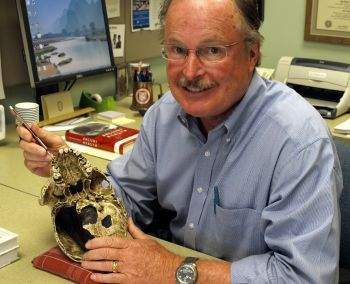
Publisher:
Bonnie King
CONTACT:
Newsroom@Salem-news.com
Advertising:
Adsales@Salem-news.com

~Truth~
~Justice~
~Peace~
TJP
Oct-14-2008 11:07

 TweetFollow @OregonNews
TweetFollow @OregonNews
Why Do Women Get More Cavities than Men?
Salem-News.comUO anthropologist reviews historical records, finds links to fertility, hormones and reproductive pressures.
 John Lukacs, professor of anthropology, shows a 250,000-year-old "Kabwe skull" from Africa. The sex is unknown, but this specimen has 15 teeth still intact or partially present -- 12 of them have obvious damage from dental caries. Photo by Jim Barlow/Courtesy: UO |
(EUGENE, Ore.) - Reproduction pressures and rising fertility explain why women suffered a more rapid decline in dental health than did men as humans transitioned from hunter-and-gatherers to farmers and more sedentary pursuits, says a University of Oregon anthropologist.
The conclusion follows a comprehensive review of records of the frequencies of dental cavities in both prehistoric and living human populations from research done around the world. A driving factor was dramatic changes in female-specific hormones, reports John R. Lukacs, a professor of anthropology who specializes in dental, skeletal and nutritional issues.
His conclusions are outlined in the October issue of Current Anthropology. The study examined the frequency of dental caries (cavities) by sex to show that women typically experience poorer dental health than men. Among research reviewed were studies previously done by Lukacs. Two clinical dental studies published this year (one done in the Philippines, the other in Guatemala) and cited in the paper, Lukacs said, point to the same conclusions and "may provide the mechanism through which the biological differences are mediated."
A change in food production by agrarian societies has been associated with an increase in cavities. Anthropologists have attributed men-women differences to behavioral factors, including a sexual division of labor and dietary preferences. However, Lukacs said, clinical and epidemiological literature from varied ecological and cultural settings reveals a clear picture of the impacts on women's oral health.
"The role of female-specific factors has been denied by anthropologists, yet they attain considerable importance in the model proposed here, because the adoption of agriculture is associated with increased sedentism and fertility," Lukacs said. "I argue that the rise of agriculture increased demands on women's reproductive systems, contributing to an increase in fertility that intensified the negative impact of dietary change on women's oral health. The combined impacts of increased fertility, dietary changes and division of labor during the move into agricultural societies contributed to the widespread gender differential observed in dental caries rates today."
Lukacs' meta-analysis looked at both prehistoric anthropological and modern health records. He repeatedly found that increases in cavities go in favor of women in adulthood. Lukacs' review found that women's higher rates of cavities are influenced by three main changes:
* Female sex hormones. Citing his own research published in 2006, he notes that these hormones and associated physiological factors can significantly impact cavity formation. A study on animals published in 1954 found that female estrogens, but not male androgens, were correlated to cavity rates. He argues for a cumulative effect of estrogens, including fluctuations at puberty and high levels during pregnancy that both promote cavities and dietary changes.
* The biochemical composition and flow rate of saliva. Women produce less saliva than do men, reducing the removal of food residue from the teeth, and that during pregnancies the chemical composition changes, reducing saliva's antimicrobial capacity.
* Food cravings, immune response and aversions during pregnancy. Lukacs points to findings that women crave high-energy, sweet foods during the third trimester, as well as an aversion to meat in first trimesters.
How the factors combine to contribute to higher risk of cavities in women as they age is not fully documented or understood, he wrote. "However, if hormonal and physiological factors work in an independent or additive manner, their impact on women's oral health could be significant. The fact that women's caries experience increases with age at a greater rate than men's in diverse ethnic groups from different ecological and cultural settings supports this interpretation."
The Alexander von Humboldt Foundation, American Institute of Indian Studies, American Philosophical Society, L.S.B. Leakey Foundation, National Geographic Society, National Science Foundation and Wenner-Gren Foundation for Anthropological Research supported the project.
Source: the University of Oregon
Articles for October 13, 2008 | Articles for October 14, 2008 | Articles for October 15, 2008

Quick Links
DINING
Willamette UniversityGoudy Commons Cafe
Dine on the Queen
Willamette Queen Sternwheeler
MUST SEE SALEM
Oregon Capitol ToursCapitol History Gateway
Willamette River Ride
Willamette Queen Sternwheeler
Historic Home Tours:
Deepwood Museum
The Bush House
Gaiety Hollow Garden
AUCTIONS - APPRAISALS
Auction Masters & AppraisalsCONSTRUCTION SERVICES
Roofing and ContractingSheridan, Ore.
ONLINE SHOPPING
Special Occasion DressesAdvertise with Salem-News
Contact:AdSales@Salem-News.com

Salem-News.com:
googlec507860f6901db00.html

Terms of Service | Privacy Policy
All comments and messages are approved by people and self promotional links or unacceptable comments are denied.
[Return to Top]
©2025 Salem-News.com. All opinions expressed in this article are those of the author and do not necessarily reflect those of Salem-News.com.